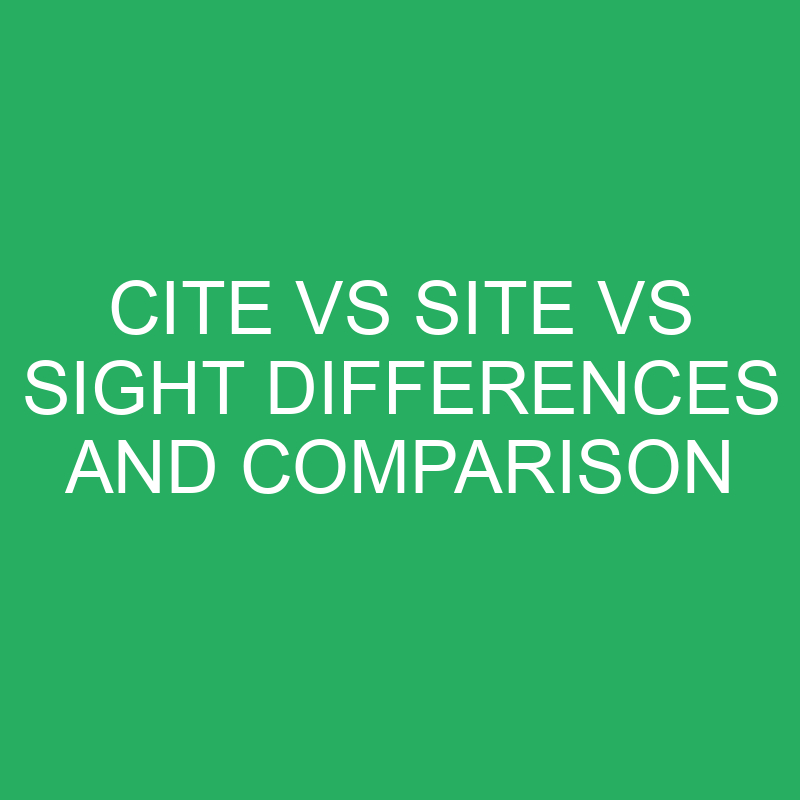“Cite,” “Site,” and “Sight” – Unraveling the Threads of Quotations, Locations, and Views
The English language, with its intricacies and multifaceted vocabulary, often presents a plethora of words that, despite sharing similar pronunciations, serve distinct purposes. A notable trio in this linguistic ensemble includes “cite,” “site,” and “sight.” These homophones play diverse roles, encompassing the act of quoting, denoting locations, and describing visual experiences. In this exploration, we will delve into the individual meanings and nuanced applications of each term, shedding light on the unique threads that weave them into the fabric of communication.
Post Contents
Cite – Quote:
Definition: As a verb, “cite” refers to the act of quoting or referencing a source, authority, or piece of information to support an argument, statement, or claim. It is commonly used in academic, literary, and legal contexts to give credit to the origin of specific ideas or information.
Examples:
- The researcher was careful to cite all relevant studies in the bibliography.
- When writing an essay, it is essential to cite the sources used for information.
Usage: In scholarly pursuits and formal writing, “cite” is a fundamental element, ensuring transparency and credibility by acknowledging the sources that contribute to the development of ideas and arguments.
Site – Location:
Definition: “Site” serves as a noun, primarily indicating a specific location or place. It can refer to physical spaces, such as construction sites or archaeological sites, as well as digital spaces, like websites. The term encompasses the concept of a defined area with a particular purpose or significance.
Examples:
- The construction company selected a suitable site for the new building.
- The historical site attracted tourists with its rich cultural heritage.
Usage: Whether in urban planning, archaeology, or the digital realm, “site” emphasizes the spatial aspect, representing a specific area that holds significance, purpose, or interest.
Sight – View:
Definition: As a noun, “sight” refers to the ability to see or the act of seeing. It can also denote a visually striking or noteworthy view or scene, often used to describe landscapes, landmarks, or visually appealing elements.
Examples:
- The mountaintop offered a breathtaking sight of the valley below.
- The city skyline at night is a spectacular sight.
Usage: In contexts related to visual experiences, aesthetics, and observation, “sight” encapsulates the beauty and impact of what one sees, whether it be a natural panorama or a man-made marvel.
Homophones: The trio of “cite,” “site,” and “sight” exemplifies homophones – words that share the same pronunciation but have different meanings. Navigating these homophones requires a keen awareness of context to decipher their intended use in both written and spoken communication.
Common Pitfalls and Clarifications:
- Sight vs. Site: View vs. Location:
- Incorrect: “The historical sight was a significant gathering place.”
- Correct: “The historical site was a significant gathering place.”
- Cite vs. Site: Quote vs. Location:
- Incorrect: “It is essential to site sources accurately in academic writing.”
- Correct: “It is essential to cite sources accurately in academic writing.”
Conclusion:
In the symphony of language, “cite,” “site,” and “sight” contribute unique notes, each playing a distinctive role in communication. From the precision of referencing and quoting to the spatial significance of locations and the visual allure of scenes, these homophones add layers to the expressive palette of English.
Armed with a clear understanding of their individual meanings, language enthusiasts can navigate the rich tapestry of communication with finesse. Whether acknowledging sources in academic writing, pinpointing a specific location, or marveling at the beauty of a scenic sight, the distinctions between “cite,” “site,” and “sight” enrich the lexicon and contribute to effective and nuanced expression.
Frequently Asked Questions (FAQs) about “Cite,” “Site,” and “Sight”
Q1: What is the difference between “cite,” “site,” and “sight”? A1: “Cite” refers to the act of quoting or referencing sources, “site” denotes a specific location, and “sight” refers to the ability to see or a visually striking view.
Q2: Can these words be used interchangeably? A2: No, these words cannot be used interchangeably. They have distinct meanings and are used in different contexts.
Q3: In academic writing, why is it important to cite sources accurately? A3: Accurate citation in academic writing is crucial to give credit to the original sources, provide evidence for claims, and avoid plagiarism.
Q4: How can one avoid confusion between “site” and “sight” in writing? A4: To avoid confusion, it’s essential to understand the context. “Site” refers to a location, while “sight” relates to viewing or a visually appealing scene.
Q5: Is there a specific format for citing sources in academic writing? A5: Yes, academic writing typically follows specific citation styles such as APA, MLA, or Chicago, each with its guidelines for citing sources.
Q6: Can “cite” be used in casual conversation, or is it more formal? A6: While “cite” is commonly used in academic and formal writing, it can also be used in casual conversation when referencing information or quoting someone.
Q7: Are there common mistakes associated with these words? A7: Common mistakes include using “site” instead of “sight” in visual contexts and confusing “cite” with “site” in referencing or quoting situations.
Q8: Can “sight” be used to describe non-visual experiences? A8: Generally, “sight” is primarily used in visual contexts. However, it can be metaphorically extended to describe striking or noteworthy experiences beyond the visual realm.
Q9: Are there alternative words for “site” and “sight”? A9: Alternatives for “site” include location, place, or area. For “sight,” alternatives can include view, scene, or panorama, depending on the context.
Q10: How can one improve their usage of these words in writing? A10: Practice is essential for improving usage. Reading diverse materials, paying attention to context, and consulting language resources can enhance understanding and usage.

